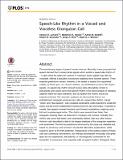Speech-like rhythm in a voiced and voiceless orangutan call
Abstract
The evolutionary origins of speech remain obscure. Recently, it was proposed that speech derived from monkey facial signals which exhibit a speech-like rhythm of ∼5 open-close lip cycles per second. In monkeys, these signals may also be vocalized, offering a plausible evolutionary stepping stone towards speech. Three essential predictions remain, however, to be tested to assess this hypothesis' validity; (i) Great apes, our closest relatives, should likewise produce 5Hz-rhythm signals, (ii) speech-like rhythm should involve calls articulatorily similar to consonants and vowels given that speech rhythm is the direct product of stringing together these two basic elements, and (iii) speech-like rhythm should be experience-based. Via cinematic analyses we demonstrate that an ex-entertainment orangutan produces two calls at a speech-like rhythm, coined "clicks" and "faux-speech." Like voiceless consonants, clicks required no vocal fold action, but did involve independent manoeuvring over lips and tongue. In parallel to vowels, faux-speech showed harmonic and formant modulations, implying vocal fold and supralaryngeal action. This rhythm was several times faster than orangutan chewing rates, as observed in monkeys and humans. Critically, this rhythm was seven-fold faster, and contextually distinct, than any other known rhythmic calls described to date in the largest database of the orangutan repertoire ever assembled. The first two predictions advanced by this study are validated and, based on parsimony and exclusion of potential alternative explanations, initial support is given to the third prediction. Irrespectively of the putative origins of these calls and underlying mechanisms, our findings demonstrate irrevocably that great apes are not respiratorily, articulatorilly, or neurologically constrained for the production of consonant- and vowel-like calls at speech rhythm. Orangutan clicks and faux-speech confirm the importance of rhythmic speech antecedents within the primate lineage, and highlight potential articulatory homologies between great ape calls and human consonants and vowels.
Citation
Lameira , A R , Hardus , M E , Bartlett , A M , Shumaker , R W , Wich , S A & Menken , S B J 2015 , ' Speech-like rhythm in a voiced and voiceless orangutan call ' , PLoS ONE , vol. 10 , no. 1 , e116136 . https://doi.org/10.1371/journal.pone.0116136
Publication
PLoS ONE
Status
Peer reviewed
ISSN
1932-6203Type
Journal article
Description
A.R.L. thanks the Menken Funds of the University of Amsterdam.Collections
Items in the St Andrews Research Repository are protected by copyright, with all rights reserved, unless otherwise indicated.

